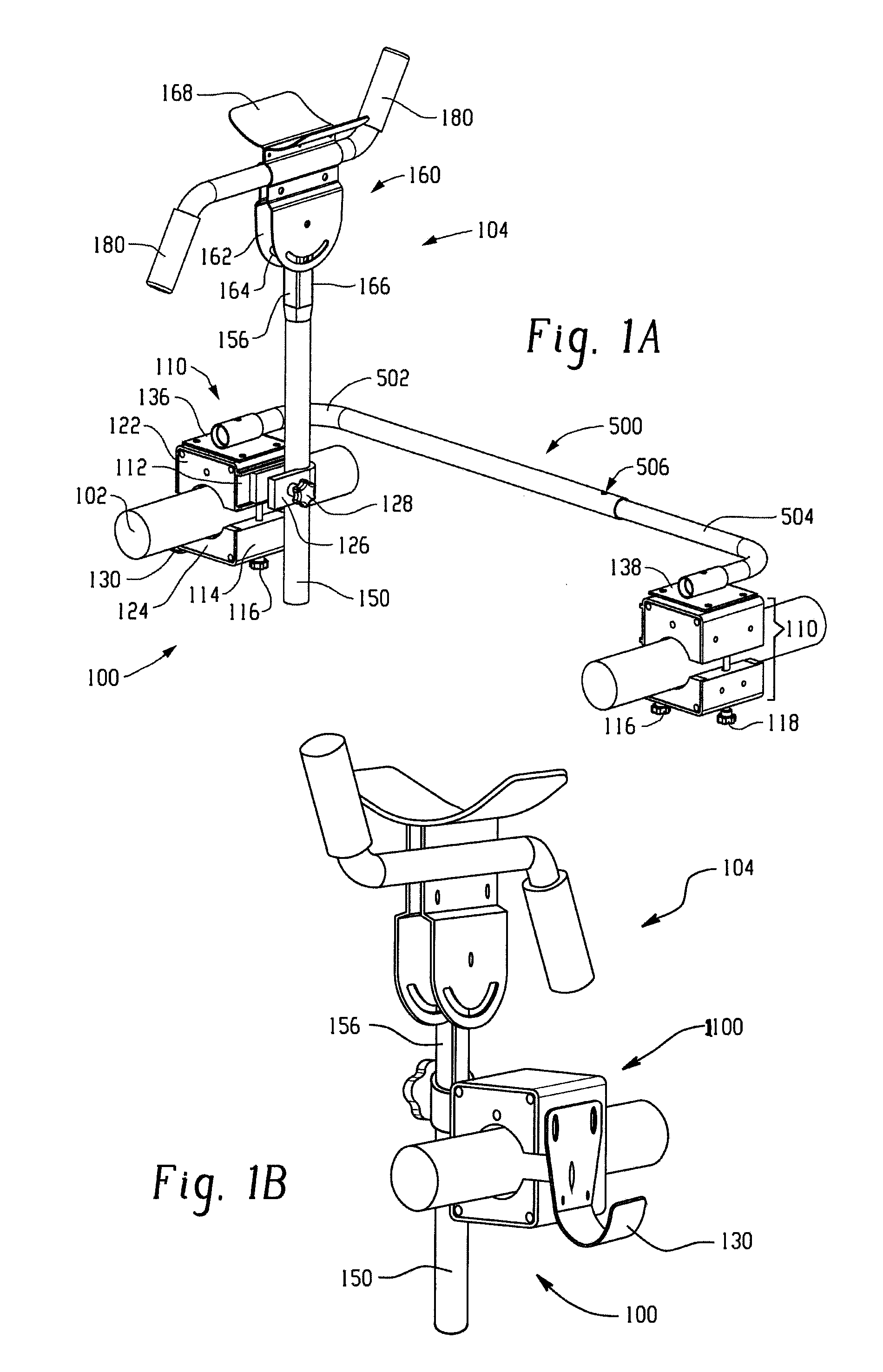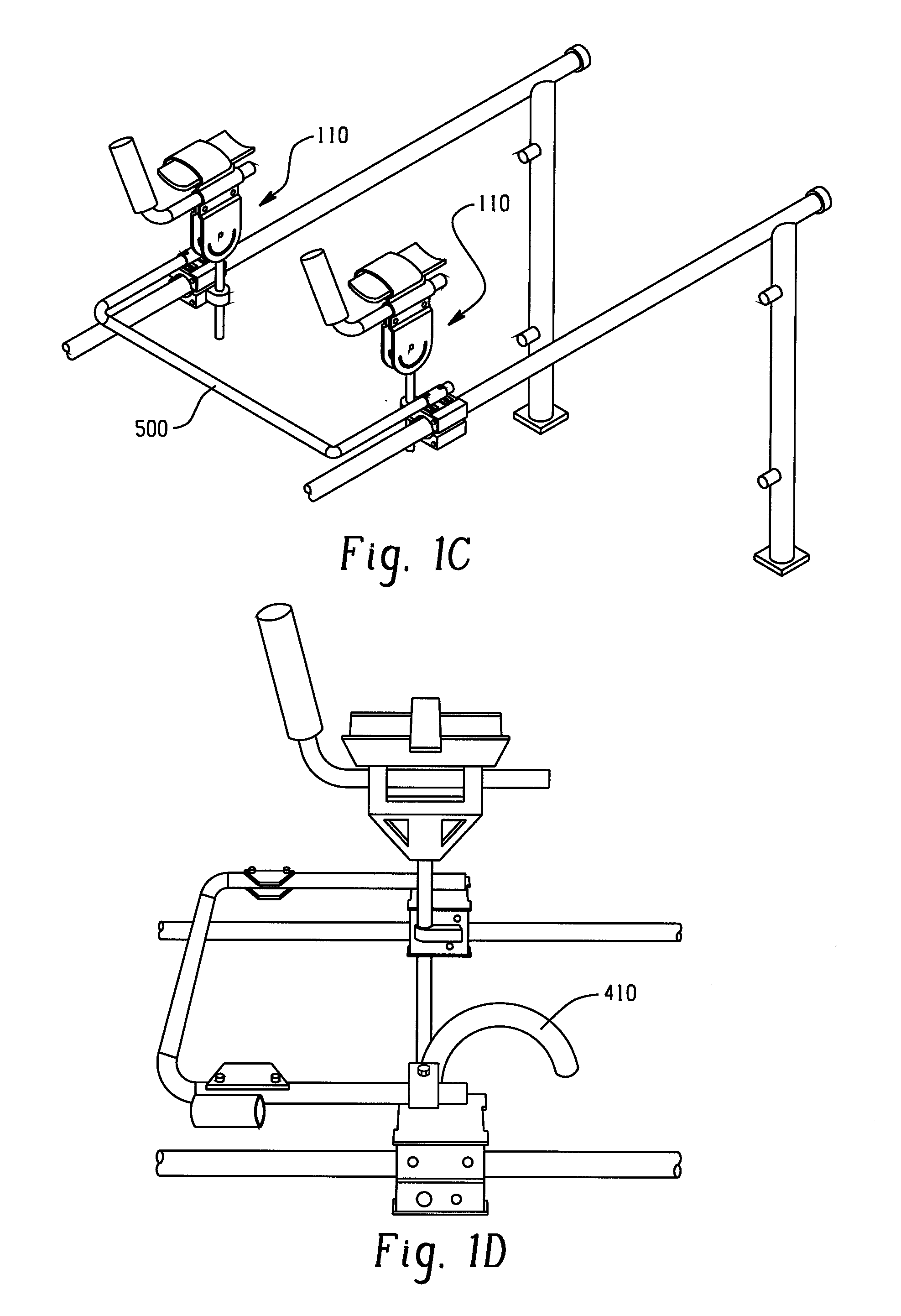In these cases, unfortunately, the entire UE is necessarily immobilized on the platform.
The weak upper extremity hangs or rests, devoid of support or stimulation during walking, which negatively affects
gait training efforts in several regards.
Indeed, rehabilitative efforts to the upper extremities during
functional training such as
gait training is often lacking as evidenced by techniques incorporated with currently available assistive devices / mobility aids, and / or mechanical limitations imposed by these devices.
Mobility aids are lacking which facilitate endeavors to normalize
gait.
“Reciprocating” walkers exist, yet good bilateral (UE) function is required to use this kind of walker (as opposed to a standard rigid framed walker) as each side must sequentially be advanced forward (to the extent that the device's design allows), and
significant risk for postural faults remains.
In terms of wheel selection, swivel wheels are often needed in order for individuals to be able to turn with a platformed walker; however, those who need this functionality the most, are at greatest risk with walking with such a device due to its inherent
instability.
Hence, functionality of platformed patient aid devices is often somewhat lacking in effectiveness in current commercially available products, particularly in terms of use with individuals afflicted with
neurologic disease.
There are also expensive wheeled devices with integrated upper body support, for overground walking, some of which are equipped with a posterior seating mechanism to further safeguard against falls.
Currently, a device which provides unilateral
forearm platform support—mobile or stationary—for use in railed environments is not available.
The
resultant technique is potentially unsafe, inefficient, cumbersome, and not as therapeutically effective.
As such, the upper extremities are able to move minimally independently of each other (unlike when the patient progresses to platformed walker use outside of the parallel bars and both UEs move simultaneously as they are affixed to the walker grip platform), yet the involved UE is largely immobilized which may be desirable in cases of orthopedic injury but which is not desirable in terms of neurologic rehab.
Later, when the patient walks outside of the parallel bars using a platformed walker, it can be confusing to some patients to grip the walker grip as opposed to the rail, while the other arm rests on the platform.
Other techniques for unilateral UE support include physical assist by a clinician, supporting the UE in a sling, walking with insufficient UE support and / or asymmetric gait and posture, placing a
crutch in cases such as UE
amputation when
residual limb strength is adequate, or using hemiplegic bars which necessitate only unilateral UE function yet thereby does not offer the therapeutic advantages of bilateral UE support needed by many recovering from
neurologic injury.
Bilateral
forearm support can be accomplished with Midland parallel bar
glider, yet this device promotes
poor posture, is unsafe without braking / resistance components, and is functional unidirectionally.
A patient necessarily releases support of one rail at a time in order to advance and, as such, parallel bars do not offer the continuous support to the patient that walkers afford.
This alternating temporary release of UE support can be problematic when significant upper body support is required in order to take steps as in the case of significant
weakness and difficulty walking as with incomplete
spinal cord injuries, which includes cases truly requiring
forearm support for adequate bodily support as well as other cases which are in need for forearm support when gripping function is nonexistent or unsafe.
In cases in which parallel bars (and treadmills) are utilized to work on the components of
normal gait, arm swinging cannot be mechanically facilitated or measured in any way, and symmetry of upper extremity excursion distance and velocity cannot be effectively addressed.
Conversely, independent movement of the UEs, if appropriate and if achieved, in parallel bars, is lost upon progression to use of a walker, unfortunately.
In parallel bars, if a patient can grip the rail yet has difficulty advancing the UE, there currently is not an apparatus available to mechanically facilitate movement.
A significant issue related to rehabilitative efforts is that higher intensities of
aerobic exercise are needed.
Generalized upper body
weakness in those with lower extremity
pathology / dysfunction often presents a fall
hazard during
gait training with walkers and in these cases, forearm platforms are used.
There currently are not alternate support surfaces for the upper extremit(ies) on these devices, nor is there a mechanism to facilitate arm movement as would be desirable as an important component of
locomotor training.
There currently does not exist a device which enables mobile UE support on a
treadmill when one is able to grip the rail such as would be therapeutic for some neurologic patients as well as for
healthy individuals requiring support yet wishing to move the arms while using a
treadmill.
The upper body is stationary and effectively immobilized when one hangs onto rails and the upper extremities are fixed anteriorly or at one's sides, and disadvantageous
excessive weight bearing through the UEs can result.
There is currently no apparatus available to provide mobile or stationary unilateral or bilateral forearm support on treadmills when one requires this type of support for reasons noted above.
Typically, if one has unilateral UE involvement such that one can support oneself with only one UE, yet remains able to ambulate on a treadmill, the involved UE remains unsupported, unstimulated, and nonfunctional, and unable to provide necessary stimulus for more symmetrical gait.
More severely-involved bariatric patients, however, are unable or unsafe to utilize these devices, due to inability to bear sufficient weight through one's arms via gripping the rail.
These units cannot be used for parallel bar or treadmill application as they are designed to attach specifically to one or more varieties of walker frames.
There are not any devices which offer mobile upper extremity support which can be variably attached to treadmill railings when platform or any other type of support is desired.
A Midland Parallel Bar
Glider is an expensive device comprised of two platform supports necessarily interconnected and which move as one piece in one direction along the rails.
The devices cannot be used to unilaterally support an UE, alternate types of support cannot be incorporated, and independent movement of the UEs cannot occur.
Significant limitations of these devices exist including, both forearms must be placed on platforms and supported, this device encourages
poor posture similar to the way that a platformed walker encourages
poor posture, the entire upper extremity is immobilized, and the units are extremely expensive and cumbersome to attach to the parallel bars.
They are not meant for use on other railed devices such as treadmills or hemiplegic bars.
Product extensions and therapeutically-stimulating linkages proposed herein cannot be incorporated with these devices.
Furthermore, with the Midland device, when a patient reaches one end of the parallel bars, the patient must be assisted to sit down, and wheeled backwards to the starting point in a
wheelchair, hence necessitating greater personnel assist and resulting in treatment inefficiencies.
Practicing turns, walking back in the opposite direction, and continuous ambulation resulting in greater distances walked is not possible with this device.
Also, sidestepping cannot be accomplished with either device.
Also, it can only be used via gripping the handles with outstretched arms.
 Login to View More
Login to View More  Login to View More
Login to View More 


